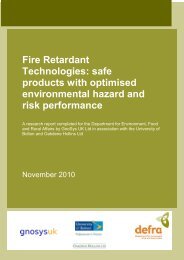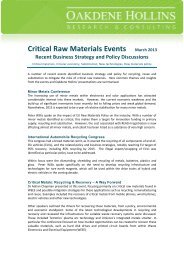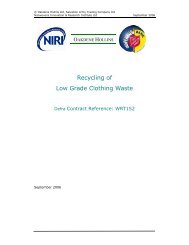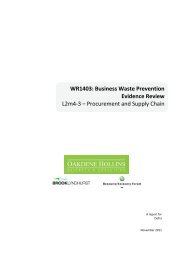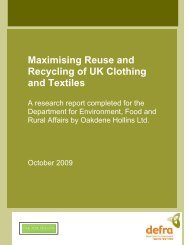Closing the Loop for clothing - Oakdene Hollins
Closing the Loop for clothing - Oakdene Hollins
Closing the Loop for clothing - Oakdene Hollins
You also want an ePaper? Increase the reach of your titles
YUMPU automatically turns print PDFs into web optimized ePapers that Google loves.
History<br />
Closed loop recycling of <strong>clothing</strong> pre-dates<br />
<strong>the</strong> industrial open-loop applications that<br />
now dominate. Wool has historically been<br />
<strong>the</strong> most recycled fibre, partly due to its<br />
previously high market share in <strong>clothing</strong>,<br />
and partly <strong>the</strong> greater ease of fibrising <strong>the</strong><br />
knitted products in which woollens have<br />
tended to predominate. The UK West<br />
Yorkshire woollen industry actually used<br />
around 40% recovered wool at its height,<br />
with shoddy mills manufacturing a lower<br />
quality cloth often used in workwear or in carpet underlay.<br />
In Sweden Stena Recycling employed over 100 people in <strong>the</strong> fibrising of cloth, to be re-spun and made<br />
into blankets or o<strong>the</strong>r products. All of <strong>the</strong>se operations disappeared over 20 years ago due to reduced<br />
demand and lack of competitiveness. The industry now resides primarily in India, but also in some North<br />
African countries, with blankets <strong>the</strong> main product. These may be low quality emergency blankets <strong>for</strong><br />
relief operations, or more stylish patterned blankets of greater value.<br />
Some small scale fibrising and res-pinning of yarn still exists in Europe. In Prato, Italy, <strong>the</strong>re is a network<br />
of companies that use <strong>the</strong> post-industrial cuttings from primary <strong>clothing</strong> manufacture, toge<strong>the</strong>r with<br />
some <strong>clothing</strong>, to re-spin yarn. Usually this is from worsted or woollen <strong>clothing</strong>. There exist o<strong>the</strong>r<br />
isolated examples of small companies carrying out respinning in Europe.<br />
Little historical evidence exists <strong>for</strong> closed loop chemical recycling of cellulosics, although cotton linters<br />
(byproducts of cotton ginning) are used in <strong>the</strong> production of cuproammonium rayon.<br />
Chemical recycling of polyester per se has been long known and a number of possible routes exist.<br />
Chemical recycling of polyester <strong>clothing</strong> was established commercially around five years ago in Japan by<br />
Teijin.<br />
Current state of play<br />
Mechanically recycled fibre from post-consumer <strong>clothing</strong> is being used in a range of small scale initiatives.<br />
For example, a coat recently launched by M&S contains fibre from “schwopped” <strong>clothing</strong> collected in<br />
M&S stores. 2 The Dutch Jeans <strong>for</strong> Jeans 3 project was able to incorporate a percentage of recycled denim<br />
from <strong>clothing</strong> into new denim yarn.<br />
A number of corporate <strong>clothing</strong> projects have created new <strong>clothing</strong> such as hoodies or scarves from used<br />
uni<strong>for</strong>ms. In this case, <strong>the</strong> fibre mix is often polyester-wool. Although not <strong>clothing</strong>, <strong>the</strong>re have also been<br />
a number of projects producing bags and similar accessories from corporate <strong>clothing</strong> 4 .<br />
The supply chain <strong>for</strong> <strong>the</strong>se products is often small scale involving pulling and re-spinning operators<br />
working on intermittent or one-off projects. Working at a small scale with modest machinery sizes<br />
and/or slower speeds can help to retain fibre length and improve <strong>the</strong> quality of <strong>the</strong> product compared to<br />
<strong>the</strong> fibre obtained from machines set up to produce large volumes of non-wovens <strong>for</strong> industrial<br />
2 http://social.marksandspencer.com/fashion-2/sustainable-fashion-<strong>the</strong>-shwop-coat/<br />
3 http://kici.nl/en/innovate/non-wearable-textiles/recycled-jeans<br />
4 http://www.wornagain.co.uk/blogs/media



